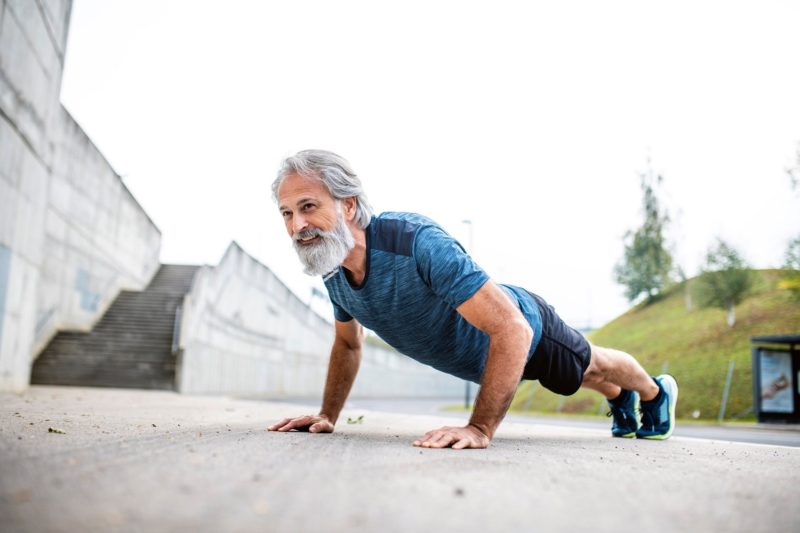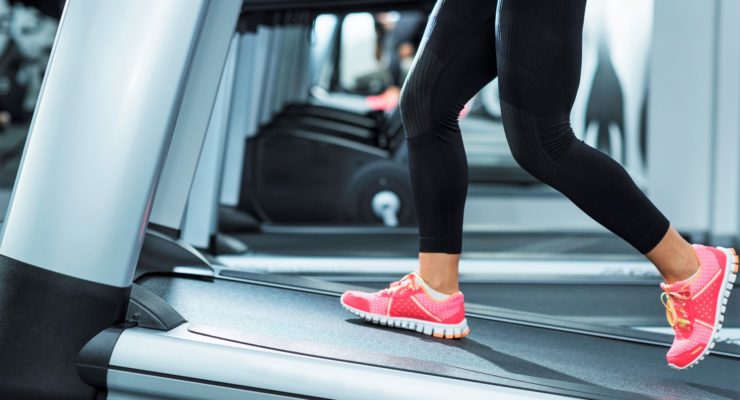Men’s Workout Routine: 6 Exercises to Strengthen Your Whole Body
Article posted in: Fitness
Minute per minute, cardiovascular exercise burns calories. This fact is why walking, running and cycling are such trusted tools for people trying to lose weight. It’s also why, when scientists tracked 234 overweight people for eight months, the group that did cardio lost more weight. The group that did cardio exercise lost an average of 3.88 pounds, while the group that did strength training alone actually gained about two pounds (though the gain was muscle).
Don’t sleep on strength, though: combine it with cardio and you get even better fitness results. A third group in that same study did both types of exercise, and reaped the rewards of both exercises. This group lost slightly less weight—at 3.59 pounds down—but they also gained muscle. Muscle gains have a positive long-term impact on weight loss because they burn more calories at rest.
Benefits of Strength Training Beyond Muscle Gains
In fact, the American Heart Association recommends strength work because it also improves your heart function, lowers heart disease risk and improves your “psychosocial well-being.” Strength training can also improve your cognitive function, your work productivity and even your sleep. You’ll be tired after hitting the gym, but you’ll have energy when you’re up; sounds like a win-win, right?
Strength training can also help fend off weight gain once you’ve hit your goals: In one study, scientists found that men who weight trained for 20 minutes per day had less age-related belly fat gains than other men who just did cardio work each day.
But with work obligations, from trying to keep up with your kids’ hectic schedules to getting chores done around the house, 20 minutes can be a challenge to set aside! So let’s make it as simple as possible: You can get in your recommended two weekly strength sessions—and keep up with your obligations and even leave a little time to stream your favorite shows—with just six simple, no-equipment exercises.
Strength-Boosting Workouts for Men
Learn the moves in the next section, and then you’ll find three workouts you can do with them to work your whole body based on the time you have—whether you’ve got four minutes, 15 minutes or 30-plus minutes to spare.
(One note: Before starting any exercise program, consult your doctor!)
These six exercises will help train your upper and lower body, your core, your balance and more. If you can’t do the exercise as written, don’t worry! For five of the moves, we’ve included a quick tip to make it simpler until you’re ready for the full chimichanga. And if one of the moves is too easy, we’ve included tips to make each a little tougher, too.
Exercise 1: Pushup

- Assume a classic pushup position, with hands directly beneath your shoulders, your body forming a straight line from head to heels.
- Maintain this rigid body line as you bend your elbows to lower your chest towards the floor.
- Press back to start, maintaining the straight body line.
Make it easier: Start with an elevated pushup. Place your hands on the second or third step of the staircase. Everything else is the same: hands should be directly beneath your shoulders, your body forming a straight line from head to heels. Just bend your elbows to lower your chest until it touches the step (instead of the ground).
To make this move even easier, use a higher step on the staircase so your hands are elevated even more. Or do presses against the wall.
Make it harder: Instead of elevating your hands, elevate your feet: Place your feet on the step and your hands on the floor directly beneath your shoulders. Now do pushups as described.
Exercise 2: Bodyweight Squat

- Stand with your feet hip-width apart, toes pointed slightly out from parallel.
- Push your hips back to initiate the squat.
- Bend your knees to descend until your thighs are at least parallel to the floor, keeping your chest up and your weight on your heels.
- Keep the weight of your body in your heels and press back to standing.
Make it easier: Squat down into a chair. Start with the chair behind you, with your feet hip-width apart, toes pointed slightly out from parallel. Push your hips back to initiate the squat and control your descent until you’re seated. Stand back up and repeat.
Make it harder: Add weight! Hold a milk jug in front of your chest with both hands, your elbows close together and your hands cupping the jug. In this position, your forearms will look like a goblet. Perform squats with the weight in this position.
Exercise 3: Bodyweight Romanian Deadlift

- Stand with feet hip-width apart, knees slightly bent.
- Push your hips back like you’re opening a door behind you with your butt. This starts the hip hinge.
- Keep pushing your hips back so that your back remains flat until it is nearly parallel to the floor.
- Squeeze your butt to return to standing. Repeat.
Make it easier: Just practice the hip hinge. Pretend you’re holding groceries in front of you, and you need to close a car door behind you using your butt. Bump your butt back to “close the door,” then squeeze your butt to stand back up.
Make it harder: Hold a weight in front of your chest with crossed arms. You can use a heavy book, or if you have one, a weight plate or dumbbell.
Exercise 4: Lateral Step-Up

- Stand with a stair or sturdy chair to your right.
- Lift your right leg up and place it on the step or chair.
- Stand up on the stair or chair by pressing through your right leg until your right knee is straight, and your left foot meets your right.
- Carefully step back down. Do all of your repetitions on this side, then switch sides and repeat.
Make it easier: Perform the move with a lower step or chair.
Make it harder: Use a higher step or chair, or add weight: Hold some cans or milk jugs in each hand.
Exercise 5: Wall Stickup

- Stand facing away from a wall, with your feet about six inches away from the wall. Your head, upper back and butt should all be in contact with the wall — and they should stay in contact with it throughout the exercise. Put your arms straight up overhead, with the backs of your hands, elbows and forearms in contact with the wall.
- Now slide your arms down the wall by bending your elbows, keeping your hands, forearms and shoulders in contact with the wall. Keep lowering until your elbows come as close as you can bring them to your sides. (You should feel a strong contraction between your shoulder blades.)
- Pause, then slide your arms back up the wall until your arms are overhead.
Make it harder: If you have access to weight machines, use the lat pulldown machine instead.
Exercise 6: Mountain Climber

- Assume the classic pushup position: Your hands should be directly beneath your shoulders, your body forming a straight line from head to heels.
- Maintaining this body line and keeping your hips parallel to the floor, lift your right foot off the ground and bend your knee so that it comes up towards your chest.
- Return your right foot to the start position, and rapidly exchange it for your left leg. Continue alternating.
Make it easier: Perform the move with your knees on the ground, so you’re in a quadruped position: Your hands should be directly beneath your shoulders and your knees beneath your hips. Straighten one leg back to its full length, then return to the quadruped position. Repeat with the other leg.
Make it harder: Instead of doing one leg at a time, jump both feet up so you’re in a squat position, then jump back to the pushup position. Repeat.
Men’s Strength Workout Plan 1: If you’ve only got four minutes…
…you’ll do a four-minute “block” of these exercises. To do each block, perform each exercise for 20 seconds, then rest for 20 seconds and move to the next exercise. Continue in this way—20 seconds of work, 20 seconds of rest—until you’ve done all six moves. This will take four minutes, and counts as one “block.”
Your goal: Do as many blocks as you have time for, whenever you’ve got an extra four minutes—while your coffee’s brewing, or the car’s warming up in the winter, or while a Nutrisystem meal heats up in the microwave. If you’ve got a little more time—20 minutes during halftime of a game you’re watching—do four or five blocks.
Men’s Strength Workout Plan 2: If you’ve got 15 minutes…
…you’ll do a circuit to get stronger and fitter over time. To do it, perform each exercise for six repetitions, then move to the next exercise with as little rest as possible. When you’ve finished all six exercises, start back at move number one. Set a timer for 15 minutes and keep going through this group until the buzzer sounds, resting as needed.
For this workout, do the exercises in this order:
- Bodyweight squat
- Pushup
- Bodyweight deadlift
- Wall stickup
- Lateral step up (perform six repetitions with each leg in each round)
- Mountain climber (perform six repetitions with each leg in each round)
So you’ll do six squats, then immediately do six pushups, then six bodyweight deadlifts … and so on. After your six mountain climbers, start back at the squats and keep cycling through until 15 minutes is up.
Your goal: Over time, the goal of this 15-minute session is to build “work capacity”—that is, to increase the amount of work you can do over a period of time. It’s a great measure of your overall fitness. So as you do this work out, keep track of how many rounds you complete in the 15-minute time period. The next time around, try to do just a little more—and keep trying to increase the amount you can get done in that time.
Men’s Strength Workout Plan 3: If you’ve got 30 minutes or more…
…go for a brisk, strength-building walk. Whether it’s around your neighborhood, in a local park or on a trail, go for a slightly brisker walk than your normal pace. Think of this as a more vigorous, “fitness walk.” Every few minutes during the walk—maybe every three minutes, every five minutes or another time interval you choose—stop walking for a minute to do two of the six exercises for two sets of six repetitions.
So if you choose five-minute intervals, walk for five minutes, then stop. You’ll then do six squats, six pushups, six more squats and six more pushups. Walk for five more minutes, then repeat with the bodyweight deadlift and mountain climber. Walk for five more, then do the same with the lateral step-up and the stickup. Continue doing this until your walk is over.
Your goal: Keep up that brisk pace and work towards 150 weekly minutes of moderate-intensity walking in this way—that’s the Centers for Disease Control and Prevention’s recommended weekly cardio—an amount that reduces your risk of early death by over 30 percent!
*Always speak with your doctor before starting an exercise routine.












